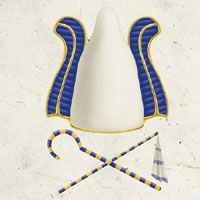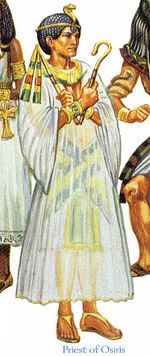Osiris, (pronounced: /oʊˈsaɪrɪs/ oh-SY-ris[5]) known as Osriant in Thay, and by the name Ozrikotep in Unther,[1] was a member of the Mulhorandi pantheon. He was a god of the dead and death itself, responsible for meting out justice in the afterlife. He was also a god of plant life, especially as it related to the harvest of food.[7]
Description[]
Osiris typically appeared in one of two primary forms. The first was that of a Mulan warrior with green skin, dressed in robes and bearing the crown of a king of Mulhorand. The second form was that of a royal mummy. A single man might appear and begin reaping the fields before disappearing, to signal the time of the harvest.[7]
Manifestations[]
The will of Osiris was often communicated through animated plants and creatures such as lammasu. A grinning skull appeared in tombs to warn away intruders. Fierce winds led an individual to the site intended for his tomb.[7]
Powers[]
Creatures were stunned merely by standing in the presence of Osiris. He possessed total control over the undead and non-sentient vegetation. He could kill with a touch, and change shape at will.[7]
Relationships[]
Osiris was the son of Geb and Nut.[1] He was the brother of Thoth, and Isis was his wife.[8]
Osiris considered Kelemvor an ally.[5]
Osiris and Set were fierce enemies. He also countered the will of Mask when possible.[1]
Worshipers[]

The Holy Symbol of Osiris.
Active worship of Osiris was small, though all in Mulhorand respected his teachings.[7]
Priests of Osiris usually wore linen skirts and sandals. They shaved their heads and usually wore a headdress. They painted a series of three concentric blue circles on their forehead, a symbol of their priestly calling.[9]
When equipping for battle, clergy of the church of Osiris favored the highest quality armor, weapons, and other equipment available, but avoided excessively displaying their wealth.[9]
Divine spellcasters of Osiris prayed for spells at dusk.[5]
Church of Osiris[]

The position of priest in the church of Osiris was usually hereditary; members typically belonged to the House of Osriant, and could claim at least one divine incarnation of Osiris among their ancestors.[7]
Priests of Osiris spent much of their time traveling Mulhorand and settling disputes. They left serious court matters to the clergy of Horus-Re. They also presided over burial procedures, and served as guardians of the Land of the Dead.[9]
The principle temples of the church of Osiris were the Crypt of Shadows located in Jhalhoran and the Gateway to the Afterworld, which was located in Mishtan. Many crypts in Mulhorand also contained shrines dedicated to the Judge of the Dead.[9]
Orders[]
Most Mulhorandi paladins were followers of Osiris.[7]
- Order of the Risen Scepter
- Drawn exclusively from those who died in combat with servants of Set and subsequently raised from the dead (perhaps spontaneously by the power of Osiris), they were primarily paladins and rangers that did nothing but hunt minions of Set. They were casual about dying because they were granted the power to return from death unaided if killed by Set's minions in an unjust or dishonorable way.[11][9]
- Brotherhood of Those Who Smile in the Face of Death
- This order of paladins served as the militant branch of the church of Osiris.[9]
- Guardians of Skuld
- Formed after the Time of Troubles and led by the church of Anhur, this organization counted followers of Anhur, Osiris, and Isis among its members.[9]
Celebrations[]
The clergy of Osiris presided over burial proceedings in Mulhorand.[9]
- Passing of Eternal Contentment and Justice
- A ceremony performed during the burial of the dead. The ceremony varied depending on the status of the deceased. Commoners received the rite of Low Passing, nobles got the rite of Middle Passing, and members of the royal family received the rite of High Passing.[9]
- Highharvestide
- A celebration of the bounty Osiris provided that year.[9]
- Midwinter
- The clergy of Osiris spent the day renewing the defensive measures protecting crypts in Mulhorand.[9]
History[]
Osiris was murdered by Set in a struggle to claim the power of slain Re. He was later resurrected by Isis and Nephthys.[1]
Appendix[]
Gallery[]
References[]
- ↑ 1.0 1.1 1.2 1.3 1.4 1.5 1.6 1.7 Eric L. Boyd (September 1997). Powers & Pantheons. Edited by Julia Martin. (TSR, Inc.), p. 120. ISBN 978-0786906574.
- ↑ Mike Mearls, Jeremy Crawford (2014). Player's Handbook 5th edition. (Wizards of the Coast), pp. 60–62, 299. ISBN 978-0-7869-6560-1.
- ↑ Jeremy Crawford, Mike Mearls, Robert J. Schwalb, Adam Lee, Christopher Perkins, Matt Sernett (November 2017). Xanathar's Guide to Everything. Edited by Kim Mohan. (Wizards of the Coast), pp. 19–20. ISBN 978-0-7869-6612-7.
- ↑ Richard Baker, James Wyatt (March 2004). Player's Guide to Faerûn. (Wizards of the Coast), p. 84. ISBN 0-7869-3134-5.
- ↑ 5.0 5.1 5.2 5.3 Eric L. Boyd, Erik Mona (May 2002). Faiths and Pantheons. Edited by Gwendolyn F.M. Kestrel, et al. (Wizards of the Coast), p. 146. ISBN 0-7869-2759-3.
- ↑ Hal Maclean (September 2004). “Seven Deadly Domains”. In Matthew Sernett ed. Dragon #323 (Paizo Publishing, LLC), p. 65.
- ↑ 7.0 7.1 7.2 7.3 7.4 7.5 7.6 7.7 Eric L. Boyd (September 1997). Powers & Pantheons. Edited by Julia Martin. (TSR, Inc.), p. 121. ISBN 978-0786906574.
- ↑ Eric L. Boyd (September 1997). Powers & Pantheons. Edited by Julia Martin. (TSR, Inc.), p. 114. ISBN 978-0786906574.
- ↑ 9.00 9.01 9.02 9.03 9.04 9.05 9.06 9.07 9.08 9.09 9.10 Eric L. Boyd (September 1997). Powers & Pantheons. Edited by Julia Martin. (TSR, Inc.), p. 122. ISBN 978-0786906574.
- ↑ Eric L. Boyd (September 1997). Powers & Pantheons. Edited by Julia Martin. (TSR, Inc.), p. 12. ISBN 978-0786906574.
- ↑ Thomas M. Reid, Sean K. Reynolds (Nov. 2005). Champions of Valor. (Wizards of the Coast), p. 103. ISBN 0-7869-3697-5.
Connections[]
Faerûnian Pantheon
Akadi | Amaunator | Asmodeus | Auril | Azuth | Bane | Beshaba | Bhaal | Chauntea | Cyric | Deneir | Eldath | Gond | Grumbar | Gwaeron | Helm | Hoar | Ilmater | Istishia | Jergal | Kelemvor | Kossuth | Lathander | Leira | Lliira | Loviatar | Malar | Mask | Mielikki | Milil | Myrkul | Mystra | Oghma | Red Knight | Savras | Selûne | Shar | Silvanus | Sune | Talona | Talos | Tempus | Torm | Tymora | Tyr | Umberlee | Valkur | Waukeen
The Morndinsamman
Abbathor | Berronar Truesilver | Clangeddin Silverbeard | Deep Duerra | Dugmaren Brightmantle | Dumathoin | Gorm Gulthyn | Haela Brightaxe | Laduguer | Marthammor Duin | Moradin | Sharindlar | Vergadain
The Seldarine
Aerdrie Faenya | Angharradh | Corellon | Deep Sashelas | Erevan | Fenmarel Mestarine | Hanali Celanil | Labelas Enoreth | Rillifane Rallathil | Sehanine Moonbow | Shevarash | Solonor Thelandira
The Dark Seldarine
Eilistraee | Kiaransalee | Lolth | Selvetarm | Vhaeraun
Yondalla's Children
Arvoreen | Brandobaris | Cyrrollalee | Sheela Peryroyl | Urogalan | Yondalla
Lords of the Golden Hills
Baervan Wildwanderer | Baravar Cloakshadow | Callarduran Smoothhands | Flandal Steelskin | Gaerdal Ironhand | Garl Glittergold | Nebelun | Segojan Earthcaller | Urdlen
Orc Pantheon
Bahgtru | Gruumsh | Ilneval | Luthic | Shargaas | Yurtrus
Mulhorandi pantheon
Anhur | Bast | Geb | Hathor | Horus | Isis | Nephthys | Osiris | Re | Sebek | Set | Thoth
Other gods of Faerûn
Bahamut | Enlil | Finder Wyvernspur | Ghaunadaur | Gilgeam | Lurue | Moander | Nobanion | Raven Queen | Tiamat
Greater Gods of Faerûn
Amaunator | Asmodeus | Bane | Chauntea | Corellon | Cyric | Ghaunadaur | Gruumsh | Kelemvor | Lolth | Moradin | Oghma | Selûne | Shar | Silvanus | Sune | Tempus | Torm
Gods of Faerûn
Angharradh | Auril | Bahamut | Berronar Truesilver | Beshaba | Garl Glittergold | Gond | Ilmater | Loviatar | Luthic | Malar | Mielikki | Sheela Peryroyl | Sseth | Talona | Tiamat | Tymora | Umberlee | Waukeen | Zehir
Exarchs of Faerûn
Abbathor | Arvoreen | Baervan Wildwanderer | Bahgtru | Baravar Cloakshadow | Brandobaris | Callarduran Smoothhands | Clangeddin Silverbeard | Cyrrollalee | Deep Sashelas | Dugmaren Brightmantle | Erevan Ilesere | Fenmarel Mestarine | Fzoul Chembryl | Garagos | Hoar | Hruggek | Jergal | Labelas Enoreth | Lliira | Maglubiyet | Malar | Marthammor Duin | Milil | Obould | Red Knight | Sharess | Shargaas | Shevarash | Shiallia | Siamorphe | Solonor Thelandira | Thard Harr | Uthgar | Valkur | Vaprak | Vergadain
Greater Deities of Faerûn
Angharradh | Bane | Chauntea | Corellon Larethian | Cyric | Garl Glittergold | Gruumsh | Horus-Re | Kelemvor | Lathander | Moradin | Mystra | Oghma | Shar | Silvanus | Sune | Talos | Tempus | Tyr | Yondalla
Intermediate Deities of Faerûn
Abbathor | Arvoreen | Baervan Wildwanderer | Berronar Truesilver | Beshaba | Callarduran Smoothhands | Clangeddin Silverbeard | Cyrrollalee | Deep Duerra | Deep Sashelas | Dumathoin | Erevan Ilesere | Flandal Steelskin | Gond | Hanali Celanil | Helm | Ilmater | Isis | Labelas Enoreth | Laduguer | Lolth | Mask | Mielikki | Nephthys | Osiris | Rillifane Rallathil | Sehanine Moonbow | Segojan Earthcaller | Selûne | Set | Sharindlar | Sheela Peryroyl | Solonor Thelandira | Thoth | Tymora | Umberlee | Urdlen | Vergadain
Major Deities of Faerûn
Angharradh | Bane | Bhaal | Chauntea | Corellon Larethian | Garl Glittergold | Gruumsh | Horus-Re | Lathander | Moradin | Myrkul | Mystra | Oghma | Shar | Silvanus | Sune | Talos | Tempus | Tyr | Yondalla
Other Deities of Faerûn
Auppenser | Abbathor | Arvoreen | Auril | Baervan Wildwanderer | Berronar Truesilver | Beshaba | Callarduran Smoothhands | Clangeddin Silverbeard | Cyrrollalee | Deep Duerra | Deep Sashelas | Dumathoin | Erevan Ilesere | Flandal Steelskin | Gond | Hanali Celanil | Helm | Ilmater | Isis | Labelas Enoreth | Laduguer | Lolth | Mask | Mielikki | Nephthys | Osiris | Rillifane Rallathil | Sehanine Moonbow | Segojan Earthcaller | Selûne | Set | Sharindlar | Sheela Peryroyl | Solonor Thelandira | Thoth | Tymora | Umberlee | Urdlen | Vergadain

